- Trekking through deep mud and sawgrass we find a stinking wallow.
- The elite rangers, dressed completely in black despite the tropical heat, mark the site with the GPS unit, measure the mucky puddle’s depth, and move on.
- This is the first sign of one of the planet’s rarest animals—the Javan rhino.
- Only 35 or so remain, including none in captivity. This patch of rainforest and swamp in Ujung Kulon National Park—on the very tip of West Java—is their last and only refuge.
Trekking through deep mud and sawgrass we find a stinking wallow. The elite rangers, dressed completely in black despite the tropical heat, mark the site with the GPS unit, measure the mucky puddle’s depth, and move on. This is the first sign of one of the planet’s rarest animals—the Javan rhino. Only 35 or so remain, including none in captivity. This patch of rainforest and swamp in Ujung Kulon National Park—on the very tip of West Java—is their last and only refuge.
Until two years ago that wasn’t the case. There was a second population of Javan rhino in Vietnam, a remnant of a species that once ranged widely across Asia. But the Vietnamese rhino was eliminated when poachers gunned down the only individual left in Cat Tien National Park. The poacher got his prize: the rhino’s horn, which in the traditional Chinese medicine market is worth $65,000 per kilogram, more than its weight in gold.
The Javan rhino is not alone in its plight. The IUCN rates three of the five remaining species of rhino critically endangered, only one step away from extinct. The Javan rhino’s closest relative, the Sumatran rhino in Sumatra and Borneo, also has a tenuous hold. Experts put the likelihood of survival of either species in coming years at 50 percent.

RPU ranger on Peucang Island. Photo by: Rhett A. Butler.
The situation in Africa, where the vast majority of rhinos survive, is not much happier. Surging horn prices—boosted by booming middle class demand in Vietnam and China—have reinvigorated the mass slaughter of rhinos. For example in South Africa, which is home to more than 70% of the world’s wild rhinos, lost 448 to poachers last year, a new record. The killing rate has worsened in 2012. Meanwhile the western black rhino, a sub-species of black rhino, was declared extinct in 2011. It too eventually succumbed to poaching.
The factors driving the demise of rhinos are relentless. Over the long term it has been habitat loss, but as the numbers have dwindled, threats have to individual populations have diverged. In Africa, where rhinos are distributed across vast savannas and often occupy unprotected or poorly protected lands, it is demand for rhino horn that mostly directly imperils populations. In Southeast Asia, where rhinos cling precariously to existence in relatively well-protected area, guarded by rangers, it is lack of suitable habitat and low population densities that are the biggest threats.
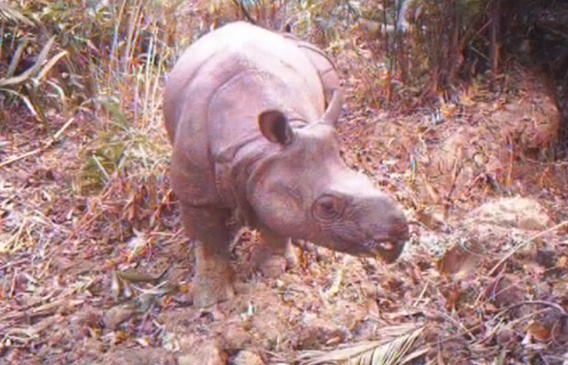
One of the last Javan rhinos captured by a camera trap in Ujung Kulon. WWF, the International Rhino Foundation, and the Aspinall Foundation have supplied the park with more than 100 camera traps. Video capture courtesy of Ujung Kulon National Park.
The state of Javan rhinos is especially precarious. Its sole habitat is an area of forest that only exists as a consequence of a massive volcanic eruption. When Krakatoa exploded in 1883, the resulting ash fallout and tsunami killed everyone living in the area that is now Ujung Kulong National Park. Fear of future calamity left the area uninhabited, allowing forest to regrow and providing the Javan rhino a refuge on an island that has been nearly entirely converted for human use. But in a land of frequent geological upheaval, the Javan rhino is vulnerable to a single cataclysmic event, be it a tsunami or disease outbreak.
These concerns, coupled with its tiny population, have spurred conservationists to make expansion of the Javan rhino’s habitat a top priority. The International Rhino Foundation is working with its local partner, the Rhino Foundation of Indonesia (YABI), and the National Park Administration to extend protected status to some 3,000 hectares of forest adjacent to the 38,000-hectare park, with a goal to boosting the population to 70-80 rhino by 2015 (population growth has been stagnant since the 1980s). The effort will not come easy: rhinos have to compete with colonists who are encroaching into the area, clearing forests for agriculture and poaching game with snares that endanger non-target species like rhino.
In 2010 and 2011 the park administration together with the YABI successfully convinced 70 farmers to abandon fields planted illegally inside Ujung Klon National Park. The farmers were compensated and provided with land outside the park. Yet incursions into the park by hunters, remain a problem. That’s where YABI’s specially trained rhino patrol units step in.
The units, which are independent of the park administration but coordinate with conservation efforts by the park authority, are specifically tasked with protecting and monitoring Javan rhino populations. They spend most of their time on foot in the forest, documenting any signs of rhino and illegal activities, although not seeking rhinos themselves (last year there was only one direct rhino sighting by the team, which logged 2,842 kilometers on patrol). The units are mostly staffed by local villagers, which provide YABI with a strong understanding of local needs and concerns about conservation programs as well as useful network of informants on poaching and other illegal activities. Jobs with YABI are well paid and have become a status symbol in some villages, where employment opportunities are limited.
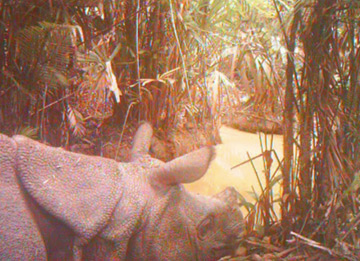 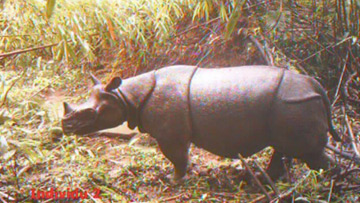 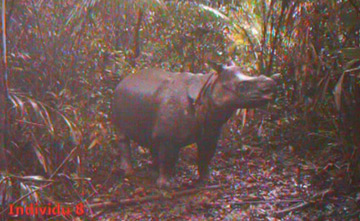 The Javan rhino. Courtesy of Ujung Kulon National Park |
YABI’s Rhino Protection Unit Manager, Muhammad Waladi Isnan, says that boosting local livelihoods could help reduce poaching pressure and encroachment provided they are consistent with conservation efforts. He has hopes that nature-based tourism could be the answer. With crystal clear water, white sand beaches, stunning coral reefs, and verdant forest on Peucang Island, less than a mile off the coast of Ujung Kulon, the appeal for tourists are obvious—in fact the area served as a fishing retreat for Indonesia’s former dictator Suharto. But unless you are a jet-setter with access to a helicopter like the displaced ruler, getting to Ujung Kulon requires commitment beyond most tourists. Tamanjaya, the village closest to the park is a six to seven hour drive from Jakarta and reaching Peucang Island takes another three to five hours, ocean conditions and weather permitting.
Waladi says improving the road to Tamanjaya would facilitate tourism and improve access to markets for farmers, yielding higher prices for their crops. But a better road could also attract colonists to the area, putting more pressure on Ujung Kulon and its resident rhinos.
But even when rhinos are protected from poaching, their survival is by no means assured, for reasons beyond the risk of cataclysm. Key rhino habitat in Ujung Kulong is losing out to the invasive arenga palm tree known locally as langkap. The palm, which produces toxic seeds useless to rhino, kills off vegetation that forms an important part of the Javan rhino’s diet. So YABI is now working with park authorities to eradicate langkap wherever they find it. Unfortunately the most effective for eliminating the palm is to dig it up by hand, a labor-intensive effort. Furthermore the rhino population is so low in Ujung Kulon that it is a risk from any outbreaks of disease, which occur from time to time.
The challenges for the Javan rhino’s closest relative are different. While its habitat has been greatly reduced by deforestation and conversion of native grasslands and swamps for agriculture, the chief problem for the Sumatran rhino is its low population density. The species is spread so thinly across Sumatra and northern Borneo, individuals can’t find one another to mate. So conservationists are taking radical measures to bring potential mates together for semi-captive breeding, including a bold capture of a wild female last year in Sabah, Malaysian Borneo. That female has now been relocated by airlift to an enclosed area of forest that is home to a male Sumatran rhino.
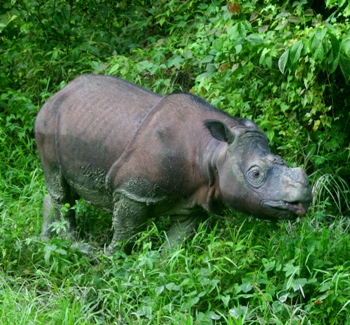 A Bornean rhino, a subspecies of the Sumatran rhino, in captivity in Borneo. Photo by: Jeremy Hance. |
“The days of leaving Sumatran rhinos in natural habitats and guarding them, hoping that they will not be poached and will breed, are passed,” said John Payne of Borneo Rhino Allliance, which led last year’s operation. “Very few of the remaining rhinos are likely to be fertile. Some of the fertile ones will have no access to a rhino of the opposite sex, because there are almost no rhinos left.”
The hope is that with good protection, adequate habitat, and facilitated match-making, the Sumatran and Javan rhinos can stage a come back. It’s happened before. In Nepal Indian rhino populations rebounded over the past few years, a combination of programs that deliver benefits to people living in and around rhino habitats and strict law enforcement. Nepal’s program is paying off. In 2012 the country proudly announced that not a single rhino had been lost to poachers in 2011. Meanwhile the southern white rhinoceros narrowly escaped a brush with extinction and now numbers more than 17,000 in the wild.
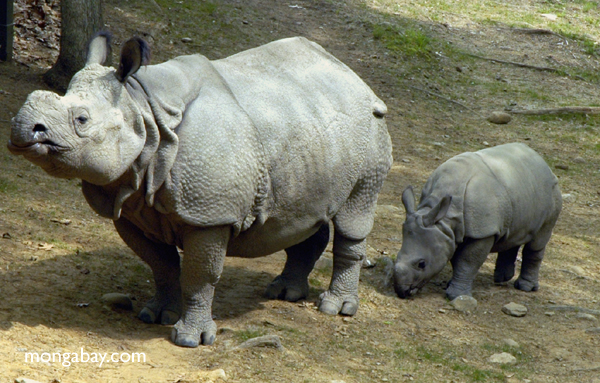
Greater one-horned rhino. Photo by Rhett A. Butler.
But while Nepal has enjoyed success, it is an outlier and the challenges to rhino conservation remain sobering, as evidenced by the sharp uptick in poaching of southern white rhinos in South Africa. One of the biggest obstacles to saving rhinos is the high price for rhino horn, demand for which primarily comes from the market for traditional Chinese medicine where horn is believed to cure cancer, inflammation, and other ills (the market for horn-based handicrafts in Yemen seems to have slowed with that country’s civil war and economic turmoil.) In the face of record high prices (an average of $65,000 a kilo in 2011) in Vietnam and China, conservationists are struggling to find a way to undermine incentives for poaching. Part of the problem is scarcity has driven up the price of horn. Scarcity is due both to the rarity of rhinos and a ban on legal trade, at least according to Michael ‘t Sas-Rolfes, an economist who focuses on the rhino horn trade.
‘T Sas-Rolfes believes that a well-regulated trade in rhino horn “harvested” from rhinos (without killing them) on farms in South Africa could help depress prices and therefore pressure on wild rhinos.
“When retail prices are rising we can typically expect poaching activity to increase if the expected costs of poaching remain unchanged,” he writes in an analysis published on his web site rhino-economics.com. “Similarly, falling retail prices should result in reduced poaching activity.”
But the idea of a legal market in horn is an anathema to many conservationists.
“What a ’legalized’ trade amounts to is encouraging sick people to consume rhino horn instead of seeking medical attention, so that certain parties may profit. Since rhino horn dealers and traders are now marketing it as a ‘cancer cure’, this presents a serious ethical issue,” said Rhishja Cota-Larson of Saving Rhinos, a group that works to stop the trade in rhino parts, and the blog Rhino Horn is NOT Medicine.
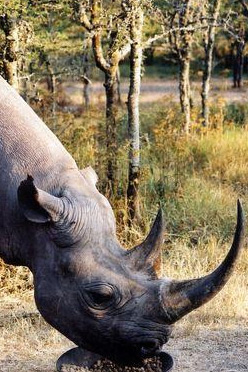 Black rhino in Africa. |
Cota-Larson fears a legal trade in rhino horn wouldn’t protect opportunistic poaching of rhino from the wild. She believes raising awareness in China and Vietnam is the long-term solution to addressing the rhino horn trade.
Sas-Rolfes doubts that awareness-raising will ever win over all those who currently use rhino horn, especially when the practice dates back thousands of years and is strongly rooted in cultural beliefs.
“Whether rhino horn can be scientifically proven to work as medicine is most likely irrelevant to those who use it,” he writes.
Either way it is clear that most rhino species, whether in Asia or Africa, face a bleak outlook given current trends. Whether rarer species are part of our future almost certainly now depends on some sort of action, both to protect rhino and actively create conditions for their survival.
“There are too few left to survive without bold human intervention,” said the Borneo Rhino Allliance’s Payne.
Should conservationists fail to save rhinos, the world will be a poor place, added Susie Ellis, Executive Director of the International Rhino Foundation, which works to protect all five rhino species, and partners with the Borneo Rhino Allliance and YABI.
“I would not want to look into the eyes of my children or my grandchildren and say ‘we could have saved the Javan rhino, if we had just tried a little harder.’”
“We have a responsibility to preserve the planet’s biodiversity for the next generations. The Javan rhinoceros represents a flagship species and symbolizes a whole swath of lost lowland rainforest habitat in Indonesia.“

Message written in the sand on Peucang Island by Waladi.
Pictures from Ujung Kulon
On June 5 Indonesia will declare 2012 the International Year of the Rhino.
This post is an expanded version of an article that appeared in April on Yale e360: Fighting A Last-Ditch Battle To Save the Rare Javan Rhino.
Video courtesy of Ujung Kulon National Park














